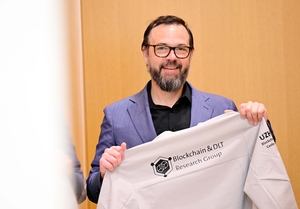Claudio Tessone of the University of Zurich says the future of crypto depends on economic design, education and integration.

The blockchain industry, once driven by speculative manias and technological zeal, is entering a more sober phase. From Switzerland’s Crypto Valley to policy committees in Seoul, regulators and developers are converging on one conclusion: the future of blockchain will depend less on code and more on the systems of trust, incentives and education that underpin it.
“Blockchain systems are socio-economic in nature,” said Claudio J. Tessone, professor of blockchain and distributed ledger technologies at the University of Zurich, in a recent interview with the Korea Herald in Seoul. “Designing them is not just about coding protocols, it is also about managing a socio-economic system, adjusting its rules and evolving with the way people use it.”
Tessone, who directs the university’s Blockchain Center and advises networks such as Cardano and Polkadot, says the industry’s deepest flaw is economic, not technical. “We still don’t know how to design appropriate incentives,” he said. “This is why the concentration of wealth and power continues to reappear, even in systems that are supposed to decentralize them.”
Rethinking decentralization
After more than a decade of experimentation, Tessone says the industry must face a hard truth: decentralization has largely failed. “The most widely used blockchains are centralized by construction, and users tolerate that – just as they tolerate inequality in traditional finance,” he said.
The problem, according to him, is not the technology, but its socio-economic design. “Blockchain can decentralize trust, but most systems have poorly designed incentives, leading to a concentration of power. »
He compares blockchain governance to running a small economy. “Designers should view blockchains as socio-economic systems and adapt the rules to how people use them – as societies do, thereby enabling healthier evolution. »
One way forward, Tessone said, lies in tools that connect the digital and real economies. Stablecoins, for example, offer a pragmatic link between blockchain and finance. “I come from Argentina, a country that has been plagued by inflation for decades,” he said. “For many people, saving and accessing foreign currencies is crucial to protecting their savings. Blockchains enable this and enable instant remittances.”
Although stablecoins could increase efficiency, he warned that their widespread use could weaken fragile currencies. “If everyone turns to the dollar or the euro, some countries could lose their monetary autonomy. »
For Korea, which is exploring a won-based stablecoin, he suggested prioritizing payments and circulation over savings. “It doesn’t need a massive supply, just constant movement.”
Smart regulation, smarter education
Switzerland’s journey shows how a long-term vision, rather than speculative fervor, can nourish a stable blockchain ecosystem. Zug, south of Zurich, became the heart of Crypto Valley in 2014, when local authorities allowed foundations to manage crypto assets – a legal experiment that quickly attracted pioneers like the founders of Ethereum.

“In Switzerland, there were already people in the financial sector who believed in the blockchain vision,” Tessone recalls. “The combination of a lean regulatory framework, financial expertise and strong capabilities in areas like IT made this a natural breeding ground. »
This foundation has helped Switzerland remain resilient despite boom-bust cycles, including the ICO crash in 2018. Today, it remains one of the most structured blockchain centers in the world, with more than 1,500 companies in Zug and a regulated environment in which even state-owned banks offer crypto products and taxes can be paid in bitcoin.
For Tessone, the next step in blockchain is not about tracking price cycles, but about building systems that last. “Complete decentralization may not be feasible – and that’s not necessarily a bad thing. Some structure improves performance,” he said. “We need smart integration of regulation and innovation to make this work. »
However, he believes that rules alone are not enough. Blockchains make it possible to produce complex financial products that few users really understand, yet are easier for providers to launch, Tessone warned.
“Without understanding, blockchain becomes a black box, like a slot machine. Investing in ‘new blockchains’ with untested and poorly understood mechanisms has fueled bubbles,” he said. “Financial education is essential to prevent people from falling into fraudulent schemes.”
The Korean Crossroads: From Speculation to Structure
For Korea, Tessone sees both caution and promise. The country is “highly digital” but is lagging behind its potential due to harsh political backlash, scams and the lingering shadow of Terra-Luna’s collapse.
“The infrastructure and the know-how exist,” he said. “What’s missing is a clear connection between public blockchains and Korea’s IoT (Internet of Things) and electronics industries.”
Regulators are now working to rebuild credibility through the Digital Assets Basic Law, a comprehensive framework aimed at defining legal boundaries and investor protections. Korea has also debated introducing a Bitcoin spot exchange-traded fund, although progress has been slower than in the United States, where regulators recently approved altcoin-based spot exchange-traded funds.
Tessone believes that Korea’s real opportunity lies in connecting its strength in electronics and autonomous devices with public blockchain networks.
“If the solutions rely on private blockchains, the added value is low,” he said. “By connecting physical infrastructure and on-chain systems, Korea could enable seamless micropayments and automated transactions.”
jwc@heraldcorp.com




